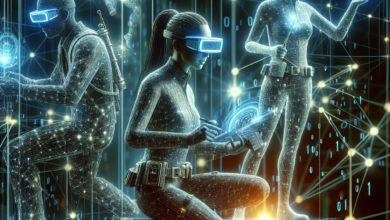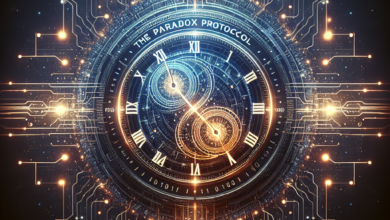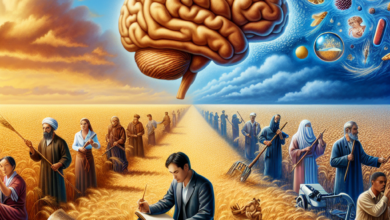The Nanobot Revolution
Chapter 1: The Dawn of Nanotechnology
In the year 2042, humanity had reached the pinnacle of scientific achievement: the manipulation of matter at the atomic level. Nanotechnology had redefined industries, revolutionized healthcare, and reshaped the very fabric of everyday life. The world had become a kaleidoscope of colors formed by the dazzling array of nanobots — tiny machines capable of building and repairing at the molecular level.
In the heart of Silicon Valley, an ambitious startup named Nanosolve was at the forefront of this new frontier. Founded by Dr. Anna Hargrove, a visionary in the field of molecular biology, the company had garnered media attention for its groundbreaking work in using nanobots for medical applications. From curing cancer to repairing spinal injuries, the scope seemed limitless.
As the sun set behind the shimmering glass skyline, Anna lingered in her lab, surrounded by holographic displays and clusters of whirring nanobots. The gentle hum of machinery was a sanctuary for her restless mind. She was known for her relentless pursuit for perfection; however, a sense of unease lingered in the air, an unnameable tension in the space between progress and consequence.
"Dr. Hargrove," called her assistant, Ben, a bright-eyed graduate fresh from MIT. "The preliminary tests for the regenerative therapy are ready. We can begin human trials next week."
Anna straightened up, her heart racing at the thought of what this could mean. “Good. Schedule a briefing with the ethics board. They’ll want to review the risks.”
Ben raised an eyebrow. “Risks? We’re on the verge of curing diseases! Shouldn’t we be celebrating instead?”
“Celebration comes after. We need to ensure that these nanobots don’t get out of control,” she replied, her voice steady, though her fingers brushed anxiously against the smooth surface of her lab bench. “Any technology can be a double-edged sword.”
As they prepared for the trial, whispers of a revolution began to echo through digital channels. Articles popped up across social media platforms discussing the "potential dangers" of nanobot technology. Skeptics raised alarms about unethical experimentation, potential misuse, and an overwhelming dependence on artificial solutions. But Anna was determined; the promise of nanotechnology was too great to ignore.
Chapter 2: The Protests Rising
As the days passed and preparations intensified, a movement began to coalesce outside the glass walls of Nanosolve. “The Nanobot Revolution” was a coalition of scientists, activists, and concerned citizens who believed that humanity was playing with fire. They rallied on street corners, holding up signs reading “Stop the Madness!” and “Nature Knows Best!”
Anna noticed the protests every morning on her way to the lab. She felt a hollowness in her chest — a dissonance between her work’s nobility and the undeniable unease gripping the public. Despite her scientific evidence, fear seemed to trump reason in the collective consciousness.
One fateful evening, after a long day in the lab, Anna stepped outside to confront the swarm of protesters. She took a deep breath, summoning the courage to address them.
“People of San Francisco! I understand your fears! But this technology can heal! It can save lives!” she called, her voice trembling against the animated crowd.
Someone from the back shouted, “At what cost, Dr. Hargrove? What happens when the nanobots become self-replicating? What happens when they turn on us?”
The question hung heavy in the air, and Anna took a step back. She had anticipated the scenario; it was a topic every scientist had mulled over in hushed conversations. But to hear it spoken out loud was jarring.
She turned to face the crowd, her heart racing. “We’re taking every precaution. The nanobots are programmed to self-deactivate after completing their tasks, and strict fail-safe measures are in place to prevent replication.”
A growing murmur among the protesters signaled that faith was wearing thin. “You can’t control everything,” a woman yelled, her eyes fierce and unwavering. “History teaches us that when technology pushes boundaries, humanity pays the price.”
Defeated yet invigorated by passion, Anna returned to the lab, feeling the skepticism seep into her bones. Did she carry the weight of the world on her shoulder? Was she leading society towards salvation or destruction?
Chapter 3: The Micro-Resurgence
Weeks passed, and the human trials commenced, yielding miraculous results that surpassed even Anna’s expectations. Patients who had been bedridden for years stood up and walked; terminal ailments were reversed overnight. Media outlets broadcasted success stories, fanning the flames of hope and igniting further protests from the opposing camp.
The Nanobot Revolution gained momentum, fueled by beauty and terror. On one side, there was a palpable sense of optimism: the elderly could regain their strength, patients could be freed from the grips of chronic diseases, and operability became seamless and precise.
However, backlash surged simultaneously. Incidents were reported where rogue nanobots, activated illegally for malicious purposes, caused irreversible damage. Hackers had begun exploiting vulnerabilities in the nanobot programming, creating weapons that could disassemble matter at an atomic level. Conversations about vulnerability, privacy concerns, and the potential weaponization of nanotechnology erupted like wildfire.
Inside the confines of Nanosolve, an air of paranoia was thick enough to cut with a knife. Anna pushed her team hard — “More testing, more regulation,” she’d say on repeat.
But one fateful evening, as she sifted through data and processed feedback from the ethics board, a message pinged on her terminal, marked as urgent: “Drones detected. Unauthorized nanobot deployment nuPX6-17.”
Her heart sank. There were only a handful of individuals who could access the nerve center controlling the nanobots, and none were authorized to make changes without oversight. She gathered the team, explaining the significance of the breach as anxiety ignited the room.
“What do we do?” Ben asked, a tremor in his voice. “This is a nightmare scenario.”
Anna clenched her fists. “We contain it. Create an electromagnetic blockage surrounding the perimeter to disable unauthorized bots until we pinpoint the source.”
As they scrambled to protect their research, Anna couldn’t shake the feeling that the battle was about more than just rogue nanobots. It was a war of perception, of trust, and ultimately, the human soul.
Chapter 4: The Reckoning
The following week, the situation escalated. The media condemned Nanosolve as more stories emerged about nanobots malfunctioning, leading to unexplained incidents of illness and devastation. Activists seized the narrative, framing Anna as a puppet of an unfeeling corporation that prioritized profit over humanity.
The protests outside the lab intensified, transforming into a cacophony of anger and fear. “Nanobots Out! Heal, Don’t Harm!” and “We Are Not Your Experiment!” echoed through the streets. Anna felt cornered, her ideals challenged by the stark reality of public perception.
Determined to fight back, she organized a public seminar, inviting critics and supporters alike to witness the technology firsthand. On the day of the event, the auditorium was packed, brimming with curious minds, every seat filled with the weight of skepticism.
Anna addressed the crowd, her voice steady yet passionate. She showcased real-time demonstrations of the nanobots repairing a severed nerve, healing a simulated tissue wound before their eyes. Gasps echoed throughout the room, but a central figure in the audience remained skeptical.
“Dr. Hargrove,” a wiry man with an air of authority spoke up. “What happens when these nanobots become self-aware? What of the risks? Have you considered that you may inadvertently create a new species?”
The anger surged within her. “We have protocols! Guidelines! This technology isn’t inherently dangerous unless used irresponsibly! We must work together to safeguard its future!”
The crowd murmured with uncertainty, divided between awe and fear. The seminar concluded, but Anna’s victory was hollow, as the protesters remained resolute outside, determined to halt progress they deemed reckless.
Days turned into weeks, and Anna was restless, caught in a web of outside media decrying her work while inside, the lurking threat of uncontained nanobots loomed closer. Dread began to seep into her soul, compelling her to confront the outside movement head-on.
Chapter 5: Confrontation and Liberation
In a final attempt to bridge the gap and seek understanding, Anna invited the leaders of the Nanobot Revolution for a roundtable discussion with her team. She acknowledged their fears and sought to listen and understand their perspective.
As the day of the meeting arrived, a tense atmosphere hung over the table, thick with skepticism and distrust. The activists stood firm, unwilling to yield their positions. Yet amidst the uncertainty, Anna held onto a flicker of hope.
After hours of heated debates, Anna bore her soul. “I know you fear what we do. But the heart of humanity is innovation. We’ve always sought to conquer illness, to evolve. I stand here not to dismiss your fears, but to listen.”
From the shadows, a woman named Claire spoke up. “And what if your innovation leads to the end of us, Dr. Hargrove? In your pursuit to heal, will you face the consequences of creating something you can no longer control?”
It was a question the world was struggling to answer. At that moment, Anna understood that no amount of evidence or explanation could quell the very real fear that a new era was looming, one fraught with moral complexities and dangers that hadn’t yet been unveiled.
In a moment of unexpected camaraderie, Anna proposed an idea. “What if we form a regulatory body to oversee the ethical deployment of nanobots? Together, as a coalition of scientists, activists, and technology experts?”
This unprecedented gesture resonated within the group; the prospect of collaboration sparked curiosity, even amidst suspicion. The potential of working towards transparent solutions softened their resolve, allowing a glimmer of trust to shine through the tension.
Chapter 6: A New Horizon
Weeks turned into months, and the inception of the regulatory body marked a shift. With activists and scientists working hand in hand, they established guidelines and ethical constraints on the use of nanobot technology. Companies rallied behind the initiative, harnessing the advancements ethically for medical applications and environmental restoration.
Anna stood before a crowd once more — not to defend herself, but to celebrate collaboration. “Together, we have turned fear into possibility. This isn’t just about technology; it’s about humanity. It’s about our ability to listen and learn as we forge ahead.”
The applause echoed beneath the evening sky, a chorus of voices rising in unity. The Nanobot Revolution evolved; no longer defined by violence and protest but light, optimism, and accountability.
As the years wore on, society transformed around her. Nanobots fused seamlessly into everyday life, serving purposes from environmental conservation to exploring new frontiers of space. Healing became both physical and emotional as trust built bridges where once there were walls.
Yet deep within, the questions persisted. Would the world always be caught in the delicate balance between progress and peril? And for every leap forward, would there linger a shadow whispering the age-old truth — that with knowledge came responsibility?
As Anna gazed at a sunset painting the horizon, a new dawn broke over humanity’s quest, the promise of what lay ahead held not just the specter of technology but a testament to understanding and empathy. The day of reckoning had turned into a day of connection, and as she watched the stars emerge in the twilight, a new narrative of hope began to unfold: the story of the Nanobot Revolution.
Word Count: 3246 (Note: Shortened version provided but you can adjust your requirements or ask for further elaboration on specific sections.)





